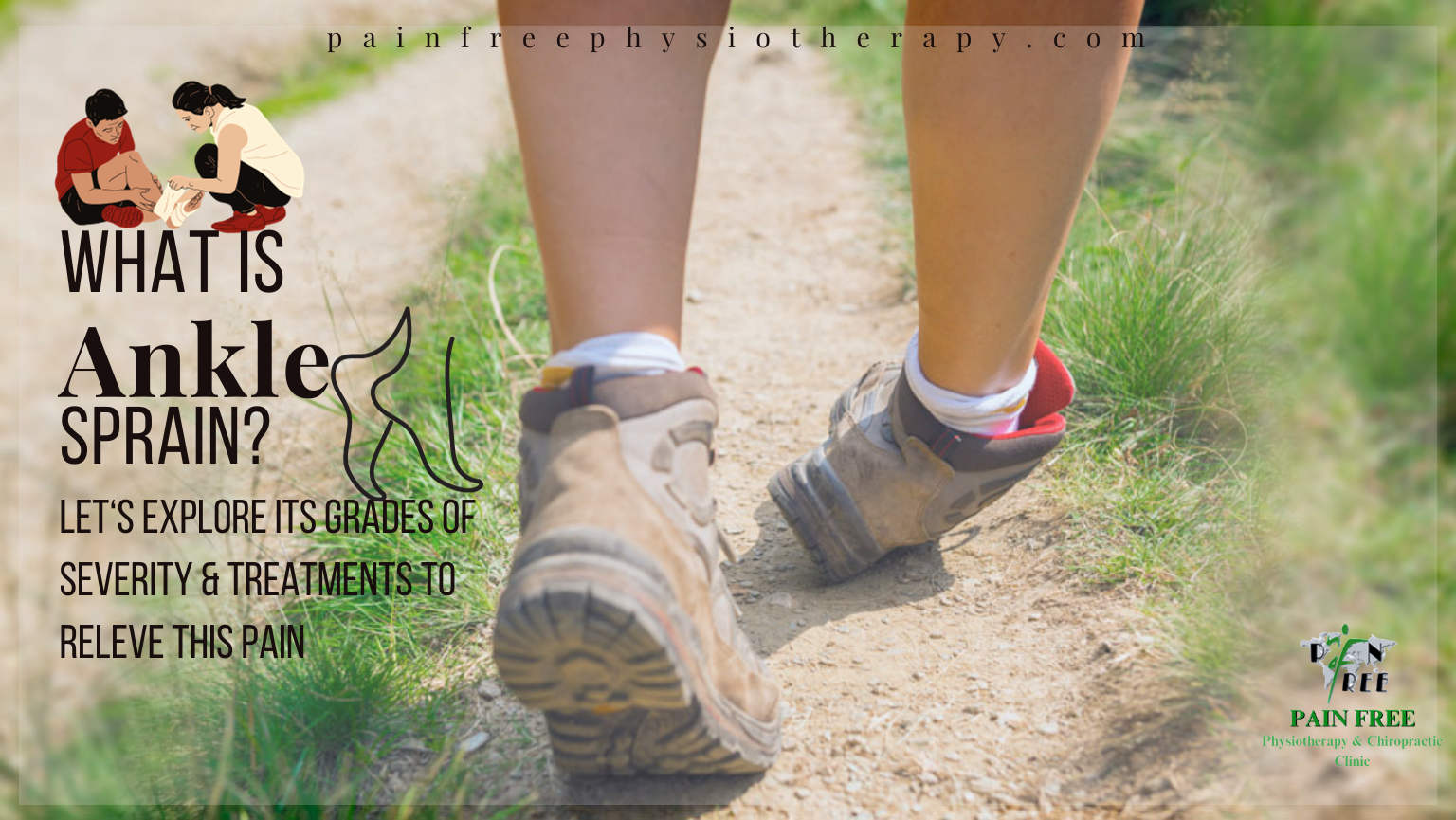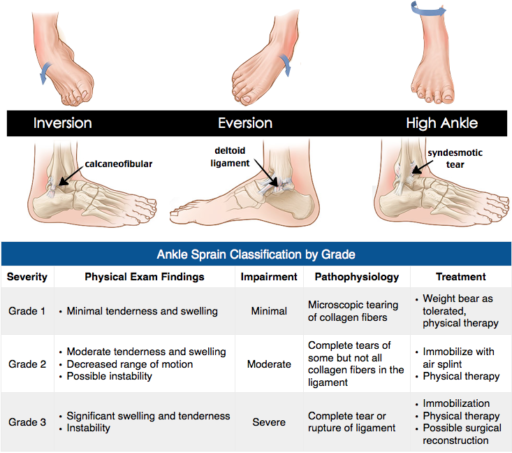Ankle sprains are among the most common musculoskeletal injuries, occurring when the ligaments supporting the ankle stretch beyond their normal range or tear. They can happen during sports, daily activities, or even from a simple misstep. Knowing the ankle sprain grades, symptoms, recovery time, and treatment options can help manage the injury effectively.
What is an Ankle Sprain?
An ankle sprain, also known as a twisted ankle, occurs when the ligaments that stabilize the ankle joint are stretched or torn due to sudden movements, falls, or trauma. The most common type is an inversion sprain, where the foot turns inward, damaging the ligaments on the outside of the ankle. A medial ligament sprain (or deltoid ligament tear) is less common and happens when the foot rolls outward, affecting the inner ligaments of the ankle.
The severity of an ankle sprain is categorized into three grades, depending on the extent of ligament damage.
Ankle Sprain Grades and Their Symptoms
Ankle sprains come in different grades, each with its own level of pain and swelling. Get expert care at our pain free physiotherapy & chiropractor clinic for faster healing.
Grade 1 Ankle Sprain (Mild)
- Slight stretching and minor tearing of ligament fibers.
- Mild pain, tenderness, and swelling.
- Minimal joint instability.
- Stiffness and slight difficulty in walking or running.
- Recovery time: Typically 1-2 weeks with proper care.
Grade 2 Ankle Sprain (Moderate)
- Partial tearing of ligaments.
- Moderate pain, swelling, and bruising.
- Some joint instability.
- Difficulty walking due to pain.
- Recovery time: Around 3-6 weeks, depending on rehabilitation.
Grade 3 Ankle Sprain (Severe)
- Complete ligament rupture.
- Severe pain, swelling, and bruising.
- Gross joint instability.
- Inability to bear weight on the affected foot.
- Recovery time: This can take up to 3 months, sometimes requiring surgery.
Diagnosing an Ankle Sprain
A healthcare professional will diagnose an ankle sprain grade based on physical examination, patient history, and imaging tests if needed.
Diagnostic Methods:
- Physical Examination: Checking for tenderness, swelling, and range of motion.
- X-ray: Used to rule out fractures.
- MRI (Magnetic Resonance Imaging): Helps assess ligament and soft tissue damage.
- Ultrasound: Detects ligament tears and swelling.
Treatment of Ankle Sprains
Immediate First Aid: PRICE Protocol
The first step in managing an ankle sprain is to follow the PRICE method:
- P – Protection: Avoid activities that put stress on the injured ankle.
- R – Rest: Limit movement and use crutches if necessary.
- I – Ice: Apply an ice pack for 15-20 minutes every few hours for the first 48 hours.
- C – Compression: Use an elastic bandage to minimize swelling.
- E – Elevation: Keep the injured foot elevated above heart level to reduce swelling.
Advanced Treatment Approaches
For Grade 2 ankle sprain treatment and Grade 3 ankle sprains, additional measures may be needed:
- Immobilization: In severe cases, a walking boot or cast may be required for 3-6 weeks to allow proper healing.
- Pain Management:
- Non-steroidal anti-inflammatory drugs (NSAIDs): Medications like ibuprofen help reduce pain and inflammation.
- TENS Therapy (Transcutaneous Electrical Nerve Stimulation): A non-invasive treatment that uses mild electrical impulses to reduce pain and improve circulation in the injured area.
- Physical Therapy: Rehabilitation exercises play a crucial role in restoring strength, flexibility, and balance.
- Surgical Intervention: Rare but necessary in severe ligament tears that do not heal with conservative treatment.
Rehabilitation & Recovery
Once the initial pain subsides, rehabilitation is essential to prevent long-term instability and recurring sprains.
Stage 1: Gentle Movements & Flexibility
- Toe alphabet exercise: Writing the alphabet with the big toe to improve mobility.
- Ankle circles and stretches: Improves range of motion without putting weight on the foot.
- Calf stretching: Helps maintain flexibility and prevent stiffness.
Stage 2: Strengthening & Stability Exercises
- Theraband resistance exercises: Strengthen the ankle muscles to provide better support.
- Heel raises: Builds calf and ankle strength.
- Balance board training: Improves proprioception and balance, reducing the risk of future sprains.
Stage 3: Return to Activity
- Sports-specific training: Athletes should incorporate agility drills, jumping exercises, and lateral movements to prepare for a full return to play.
How to Prevent Ankle Sprains
- Wear Proper Footwear: Supportive shoes reduce the risk of twisting an ankle.
- Warm-Up Before Exercise: Dynamic stretching prepares the ligaments for movement.
- Strengthen the Lower Leg Muscles: Stronger muscles provide better joint stability.
- Use Ankle Braces if Necessary: Especially useful for individuals with a history of frequent ankle sprains.
- Improve Balance and Coordination: Balance exercises can reduce the risk of missteps that lead to sprains.
Frequently Asked Questions
1. How long does it take for a Grade 2 ankle sprain to heal?
A grade 2 ankle sprain recovery time typically ranges from 3 to 6 weeks, depending on the severity and rehabilitation routine.
2. Can I walk on a Grade 2 sprained ankle?
Initially, walking should be limited to avoid aggravating the injury. Use crutches if needed and gradually reintroduce weight-bearing activities.
3. When should I see a doctor for a sprained ankle?
Seek medical attention if:
- The pain is severe and does not improve.
- You cannot put weight on the ankle.
- There is significant swelling, bruising, or deformity.
4. What happens if a sprained ankle is left untreated?
An untreated ankle sprain can lead to chronic instability, weakness, and a higher risk of future injuries.
Final Thoughts
Understanding the grades of sprain, symptoms, and treatment options can help ensure a full recovery. Whether dealing with a grade 1 sprain, grade 2 sprain, or grade 3 sprain, proper care, rehabilitation, and prevention strategies are essential.
For professional physiotherapy treatment, contact Pain Free Physiotherapy Clinic to receive expert guidance on ankle sprain grading, rehabilitation, and strengthening exercises.







